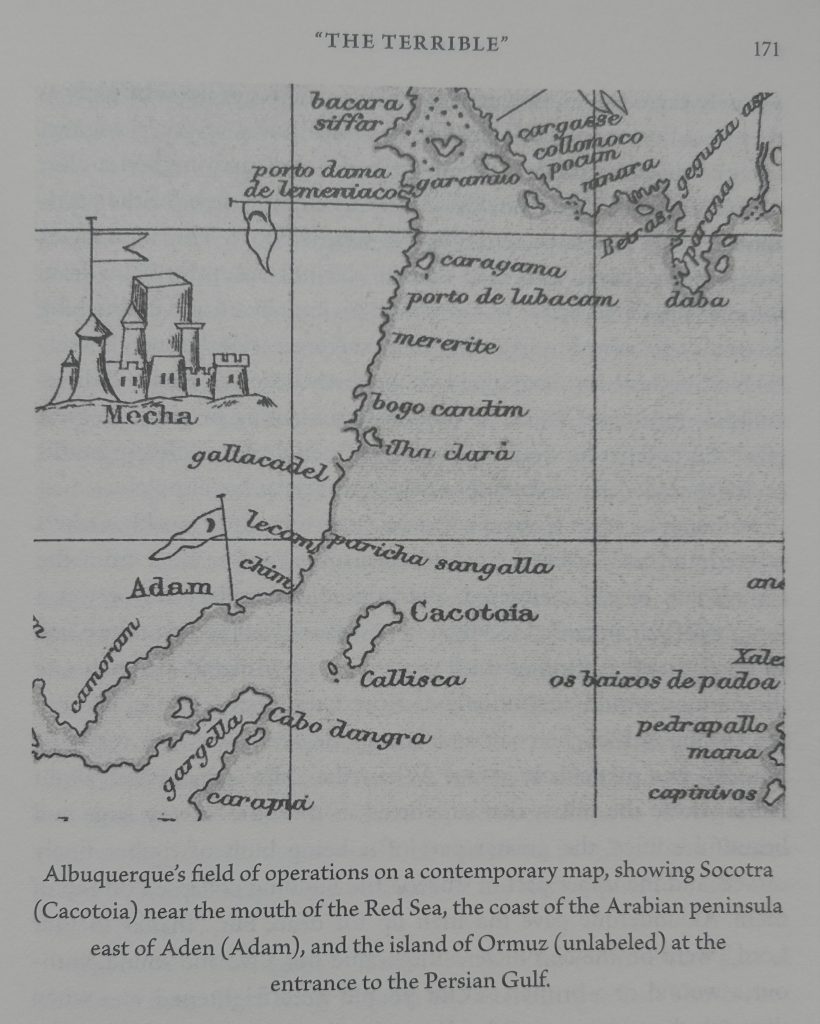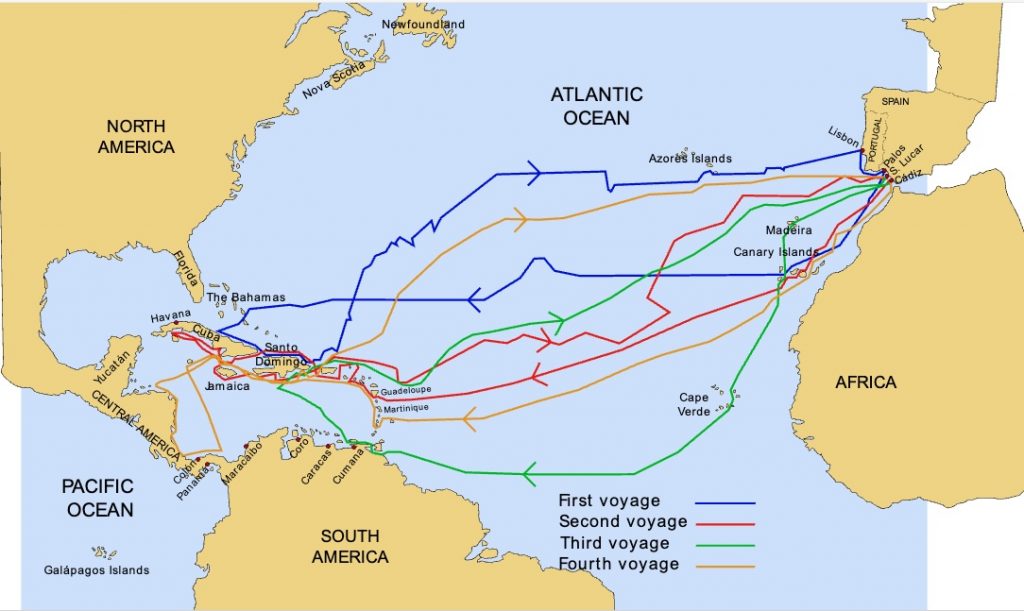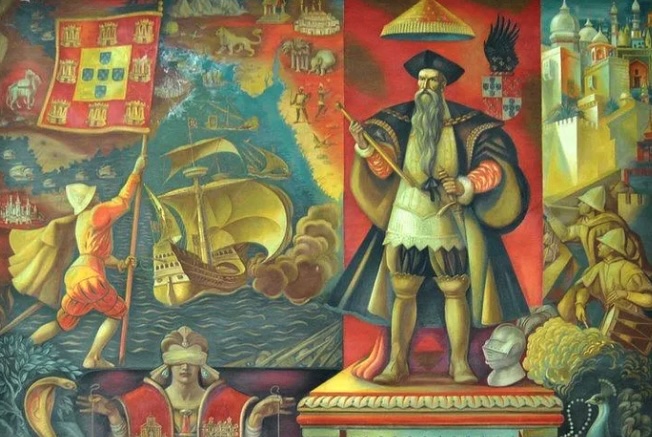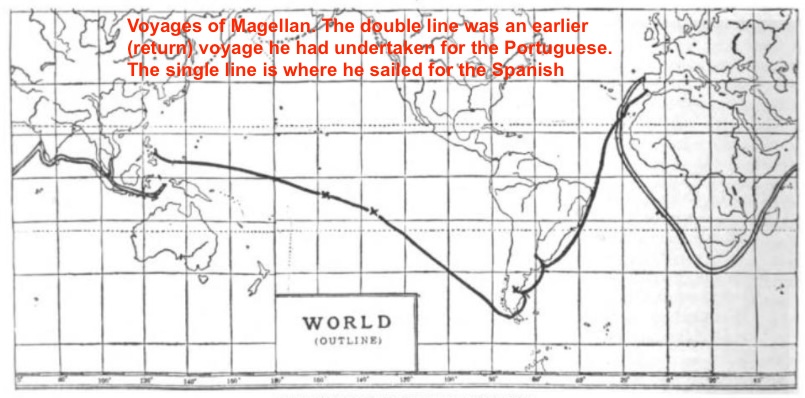The painting above is of Portuguese conquistador Afonso de Albuquerque
For Pres. Trump, cruelty is a vital tool as he bulldozes through all constitutional requirements to undertake (and publicize) exemplary deportations of undocumented immigrants and of any legally documented visitors like Columbia University’s Mahmoud Khalil whom he arbitrarily chooses to punish.
For Israel’s PM Netanyahu and his ministers, cruelty is similarly a vital tool as they deploy waves of bombers and incendiary drones against two million Palestinians huddling under tarps on Gaza’s trash-piled shores while totally blocking the entry into Gaza of all the basic necessities of life.
It’s worth noting that cruelty has been a vital, and deliberately deployed, tool for the architects and commanders of “White” empires ever since the 15th century CE. In 1415, Portuguese navigators started carving their way down the coast of West Africa to establish heavily fortified “trading” (plunder) posts in their quest for gold. Those navigators were also intent on finding a sea-route to the richest trading zone they’d ever heard of, the one that traversed the Indian Ocean and wove the riches of East Africa, India, and distant Cathay (China) into the most advanced manufacturing and consumption area then known to humankind…
In early 1498– just six years after Spain’s Ferdinand and Isabella sent Christopher Columbus’s expedition off to discover a sea-route to China by sailing West— a Portuguese expedition led by Vasco da Gama successfully rounded the southern tip of Africa and sailed across the Indian Ocean to land near Calicut, in southern India.
Calicut’s ruler was deeply unimpressed by the gifts that King Manuel I had chosen for da Gama to present to him. That first encounter did not go well, but da Gama made it safely back to Lisbon 15 months later. Manuel then sent a stream of follow-on expeditions, timing them to catch the needed winds in both the Atlantic and Indian Oceans.
For the fourth expedition, Manuel once again chose da Gama to lead it. In this essay from 2021, I noted that da Gama’s orders from King Manuel were to “guard the mouth of the Strait of the Red Sea, to ensure that there neither entered nor left by it the ships of the Muslims of Mecca, for it was they who had the greatest hatred for us, and who most impeded our entry into India…”
After da Gama’s fleet reached the southwest Indian coast a little north of Calicut, they started looking for Muslim ships using that shore-hugging route to take merchants and pilgrims up to the Red Sea and Mecca. Soon, da Gama’s people spotted a large dhow called the Miri that was returning from the pilgrimage to Mecca, carrying 240 men, including a number of rich merchants, as well as women and children. As the British historian Roger Crowley wrote in his brilliant book Conquerors: How Portugal Forged the First Global Empire, “There were well-observed rules along the Malabar Coast. It had become practice to pay a toll if intercepted by pirates on certain stretches, and the merchants were well-provided, confident that they could pay their way.”
But da Gama wanted something else: he wanted to teach everyone along that coastline a lesson. As Crowley wrote:
To the disbelief of the Miri’s passengers… the ship was stripped of her rudder and tackle, then towed some distance away by longboats. Bombardiers boarded the ship, laid gunpowder, and ignited it. The Muslims were to be burned alive… For five days, the disabled Miri floated on the hot sea.

Over the years that followed Manuel continued sending heavily armed and brutal expeditions along the lengthy sea-route into the Indian Ocean. Crowley tells us (p.170) that the new instructions sent with the 1506 expedition specified that its goal should be to guard the mouth of the Red Sea and capture Muslim cargo ships, as before, and it should also “establish treaties in places that seem useful such as Zaila, Barbara, and Aden, also go to Ormuz, and to learn everything about these parts.” (The word “impose” would probably have been more apt there, than “establish”.)
The commander tasked with doing this was a battle-hardened guy called Afonso de Albuquerque. Crowley tells us, p.172, how he fought his way along the Omani coast:
Some of the ports along the Omani coast submitted meekly. Others resisted and were sacked. Swarms of criminalized seamen from the Lisbon jails looted, murdered, and burned. Exemplary terror was a weapon of war, intended to soften up resistance farther down the coast. In this fashion, a strong of small ports went up in flames. In each one the mosque would be routinely destroyed; the destruction of Muscat, the trading hub of the coast… was particularly savage… Albuquerque was intent on transmitting terror ahead of him: “he ordered the ears and noses of captured Muslims to be cut off, and sent them to Ormuz as a testimony to their disgrace.”
Crowley’s book has an entire chapter titled “The Uses of Terror.” Well worth reading.

While King Manuel and his admirals were building that first-of-a-kind West European empire in the Indian Ocean, Christopher Columbus was undertaking his four pioneering voyages to the Caribbean on behalf of the monarchs of Castile.
From at least the second voyage on, Columbus treated the Indigenous people whom he encountered with great, and usually deliberate cruelty. The naval cannons and muskets at his men’s command had no match among the native people of the region, many or all of whom had never previously encountered even a well-honed sword.
The Spanish Conquistadores extended there, to the Caribbean lands, the super-cruel practices of domination the Castilians had long used to subdue the formerly Muslim and Jewish residents of the Iberian Peninsula during the decades of their “Reconquista” there.
(Until his death in 1506, Columbus still thought the Caribbean lands he conquered were lying just off the coast of China or India.)
Over the decades that followed, the Spanish were able to plunder massive amounts of silver and other resources from the whole “New World” that they “discovered” in the Americas. They established vast plantations across much of the Caribbean and central America and seized control of Peru’s whole silver-mining operation.
In 1493, the Catholic Pope had “divided” the plundering/colonizing rights for the whole world between these two first great Catholic imperial powers by brokering the Treaty of Tordesillas. All the land west of the Tordesillas Line was open for plundering and ravaging by Castile/Spain, while the treaty left Portugal free to impose as much control as it was able over the trading networks of the Indian Ocean without competition from Castile. (Portugal also got to monopolize the extraction of enslaved persons from Africa, many of whom it sold to the Spanish for a significant profit.)
In 1520, Ferdinand Magellan, a Portuguese navigator working for the Spanish, successfully sailed around the southern tip of South America, then across the Pacific to the portion of the Spice Islands soon thereafter renamed the Philippines. That was an area of long and strong Portuguese interest, but once again the Pope was able to establish a demarcation line between the two Catholic Empires– with the Spanish winning his approval for their colonization of the Philippines.
From the mid-16th century on, religious differences started to inflame much of Western Europe. In England, Henry VIII and his daughter Elizabeth and in the Netherlands large networks of Protestant traders all rebelled against Catholic domination. The English and Dutch started to work systematically to undercut the sources of Spain’s wealth by attacking the huge trans-Atlantic galleons in which it carted silver from (mainly) Peru back to Spain, where it was used mainly to finance the large-scale wars Spain’s Hapsburg monarchs were waging all over Europe. Expert English and Dutch navigators also found their way around the southern tip of Africa to challenge the extensive trading networks the Portuguese were now running in the Indian Ocean…
Along the way, those two upstart White empire-builders also discovered the utility of private capital in financing transoceanic plunder raids, and invented stock markets. Those inventions speedily enabled them to out-compete the lumbering, older, and much more feudally-run Catholic empires.
The British and Dutch, and then the White imperial projects later launched by France, Germany, and Italy, also relied on a considerable amount of exemplary violence to build and maintain their global empires.
The Zionist project in Palestine was a late starter in this European-origined, settler-colonial “race” to control and plunder parts of the non-White world. From 1917 on the Zionist leaders worked closely with the British/English and learned a lot from them, steadily building up fortified colonies in Palestine throughout the 30 years the British ruled it under their “mandate” from the League of Nations.
In 1945 the Allied war effort successfully crushed Nazi Germany. But it left the entire British/English empire exhausted and depleted. In the post-war years, London decided it had no choice but to divest itself of the whole of the Indian “jewel” in the empire’s crown. Hundreds of millions of Indians were able to throw off the British yoke– amidst, it is true, some truly grisly inter-communal violence that had been incubated over many decades through London’s policies of “divide and rule.”
And in that exact same period, the Zionist leaders saw their chance to consolidate their settler-colonial project in Palestine in a way, and to an extent, that just a few years earlier they would not have dared to dream of. Using organized, terrorizing violence and extreme, “exemplary” cruelty, in 1947-49 they carved their “Jewish state” onto a majority of the land of Mandate Palestine while dispossessing its people and erasing most of the legacy of their presence there.
Over the decades since 1949 the Zionists have maintained and considerably extended their settler colonial project through systematic and often shockingly extreme violence and cruelty. The cruelty is deliberate, glorified, and meant to teach and re-teach the “natives” their lesson.
Back in 1930, the Indian leader Mahatma Gandhi, was asked what he thought of Western civilization. His response was short. “It would be a good idea.” Still so true today.





